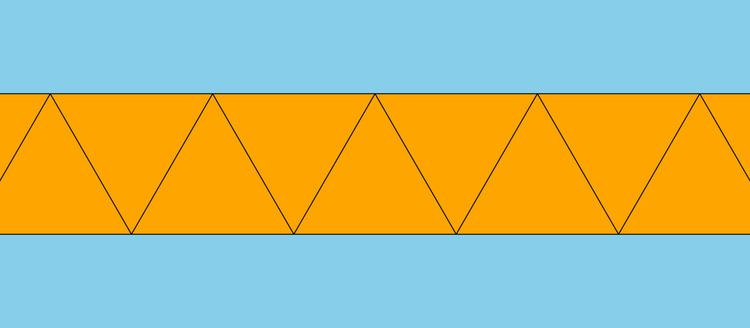Edges and vertices ∞ Symmetry group D∞d, [2,∞], (2*∞) | Schläfli symbol {∞}#{ } | |
 | ||
In geometry, an infinite skew polygon (or skew apeirogon) has vertices that are not all colinear.
Contents
- Regular skew apeirogons in two dimensions
- Isogonal skew apeirogons
- Hyperbolic skew apeirogons
- Helical apeirogons in 3 dimensions
- Isogonal helical apeirogons
- References
Two primary forms have been studied by dimension, 2-dimensional zig-zag skew apeirogons vertices alternating between two parallel lines, and 3-dimensional helical skew apeirogons with vertices on the surface of a cylinder. In 2-dimensions they repeat as glide reflections, as screw axis in 3-dimensions.
Regular skew apeirogon exist in the petrie polygons of the affine and hyperbolic Coxeter groups. They are constructed a single operator as the composite of all the reflections of the Coxeter group.
Regular skew apeirogons in two dimensions
A regular skew zig-zag aperiogon has 2*∞, D∞d Frieze group symmetry.
The zig-zag regular skew apeirogons exists as Petrie polygons of the three regular tilings of the plane: {4,4}, {6,3}, and {3,6}. These apeirogons have internal angles of 90°, 120°, and 60°, respectively, from the regular polygons within the tilings.
Isogonal skew apeirogons
A skew isogonal apeirogon alternates two types of edges with various Frieze group symmetries. Distorted regular skew apeirogons produce zig-zagging isogonal ones with translational symmetry.
Other isogonal skew aperigons have alternate edges parallel to the frieze direction. These all have vertical mirror symmetry in the midpoints of the parallel edges. If both edges are the same length, they can be called quasiregular.
Example quasiregular skew apeirogons can be seen in the Euclidean tilings as truncated Petrie polygons in truncated regular tilings:
Hyperbolic skew apeirogons
In hyperbolic geometry, regular skew apeirogons are similarly found like in the Euclidean plane.
Hyperbolic regular skew apeirogons also exist as Petrie polygon zig-zagging edge paths on all of the regular tilings of the hyperbolic plane. And again like Euclidean space, hyperbolic quasiregular skew apeirogons can be constructed as truncated petrie polygons within the edges of a truncated regular tiling.
Helical apeirogons in 3-dimensions
A helical skew apeirogon can exist in three dimensions, where the vertices can be seen as limited to the surface of a cylinder. The sketch on the right is a 3D perspective view of such a regular helical apeirogon.
This apeirogon can be most seen as constructed from the vertices in an infinite stack of uniform n-gonal uniform prisms or antiprisms, although in general the twist angle is not limited to an integer divisor of 180°. A helical skew apeirogon has screw axis symmetry.
An infinite stack of prisms, for example cubes, contain a helical apeirogon across the diagonals of the square faces, with a twist angle of 90° and can be represented as {∞}#{4}.
An infinite stack of antiprisms, for example octahedra, makes helical apeirogons, 3 here highlighted in red, green and blue, each with a twist angle of 60° and can be represented as {∞}#{6}.
A sequence of edges of a Boerdijk–Coxeter helix can represent regular helical apeirogons with an irrational twist angle:
Isogonal helical apeirogons
A stack of right prisms can generate isogonal helical aperigon alternating edges around axis, and along axis, here for example with square prisms, alternating red and blue edges:
Similarly an alternating stack of prisms and antiprisms can produce an isogonal helical apeirogon, here for example, a triangular one with one shown:
An isogonal helical apeirogon with an irrational twist angle can also be constructed from truncated tetrahedra stacked like a Boerdijk–Coxeter helix, alternating two types of edges, between pairs of hexagonal and pairs of triangular faces:
